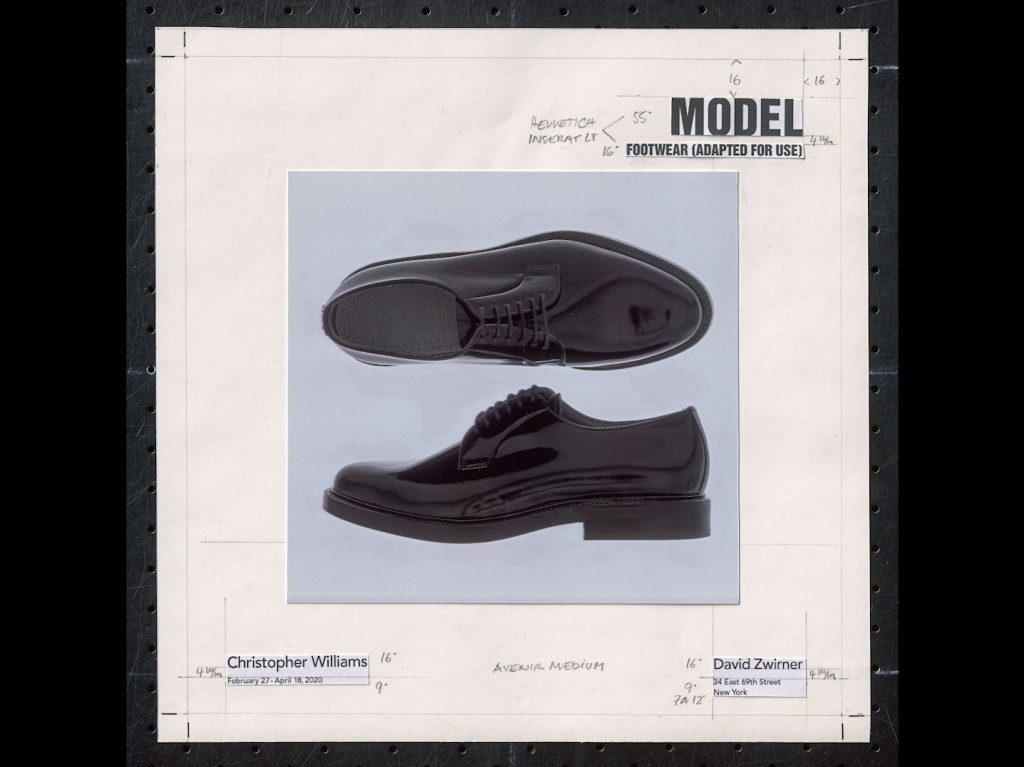[ad_1]
If you board a taxi in New York right now, you’ll most likely see the usual videos playing on a small monitor screen: canned news broadcasts about happenings around the world, advertisements for phone service providers, and so on. But there’s also one unexpected clip newly making the rounds: a static shot of what appears to be an advertisement for black shoes, along with a loud ringing noise. After 30 seconds (five of them with that sound blaring), the image disappears—and it’s back to the usual programming.
The short clip is not an advertisement but an artwork by Christopher Williams, a photographer whose sleek images resembling promotional materials for products that don’t exist have delighted and confused many a seasoned viewer over the past few decades. Williams’s name is visible in the video, just barely, in the lower lefthand corner; nearby it is the name and address of David Zwirner gallery, which is now hosting a two-channel version of the video as part of a solo show on the Upper East Side for Williams, who is based in Cologne, Chicago, and Los Angeles. Those in the know may even recognize that the taxi video in relation to an art-world prank of sorts: its image is the mock-up for an ad that Williams placed in the March issue of Artforum, with handwritten marks denoting its Avenir typeset and the inches of its spacing intact.
Will everyone—or even anyone—who sees the video in the wild understand it? Probably not, Williams said, but that’s not an issue. “Useful language that works well for one audience but doesn’t communicate to anyone else is interesting to me,” the artist said in David Zwirner’s backroom earlier this week. “I always think of the double address.”
One could philosophize endlessly about such an artwork. Take it as an advertisement for an advertisement (or maybe don’t—as Williams thinks people have overstated the influence of commercial photography on his pictures). Or maybe it’s a Brechtian gesture meant for the kind of people who might invoke the phrase “Brechtian gesture.” Or some kind of statement about image-making and capitalism. Or simply something to laugh at.
Williams’s photography is loaded with theories and ideas, and he wants to indulge them all. “I think of genre and existing ideas in pictures as a car sitting on the road with a full tank of gas and keys in the ignition,” he said. “What I do is: get in and drive.”
Williams first embarked on the taxi TV project as a joke, when colleagues at his gallery worried that the full video it relates to might not sell. “What kind of audience do you imagine for this?” they asked. He responded, “Let’s put it into mass media.”
A mega-gallery like Zwirner is “involved with a pretty refined history and [has] a very select audience,” Williams said. Whereas the intriguing medium of taxi TV differs a bit. “I don’t want to be hierarchical and call it a sub-level, but it’s really a street-level form of communication.”
The footwear in the work is a simple black German shoe. (Into that shoe he inserted an insole, also black and also German.) Williams considers the exhibition in which it appears a “period piece” relating to the 1960s and ’70s, and one of the four different titles he gave the show reads: “How German Is It?”
Asked how German the taxi TV work might be, Williams said there was a good deal of crossover between German and American culture in the ’60s and ’70s. “The dreams of the Communist East and the dreams of the capitalist West are actually very similar.”
In the days to come, the taxi TV project has a chance of getting in front of an international art-world audience by surprise—as attendees make their way to the ADAA Art Show at the Park Avenue Armory and then the big Armory Show art fair next week. “Targeting the art fair is a funny idea,” Williams said, “because a lot of those people will actually get it.”
Below, see the 30-second video appearing in taxis now, followed by one of the two 30-minute versions on view at David Zwirner.
Christopher Williams, Adapted for Use: Provisional Prop, Klebelayout, hochtransparentes Zeichenpapier entfernt (Taxi TV version), 2020.
©Christopher Williams/Courtesy the artist, David Zwirner and Galerie Gisela Capitain, Cologne
Christopher Williams, Provisional Prop, Klebelayout, hochtransparentes Zeichenpapier entfernt, 2020.
©Christopher Williams/Courtesy the artist, David Zwirner and Galerie Gisela Capitain, Cologne
[ad_2]
Source link

